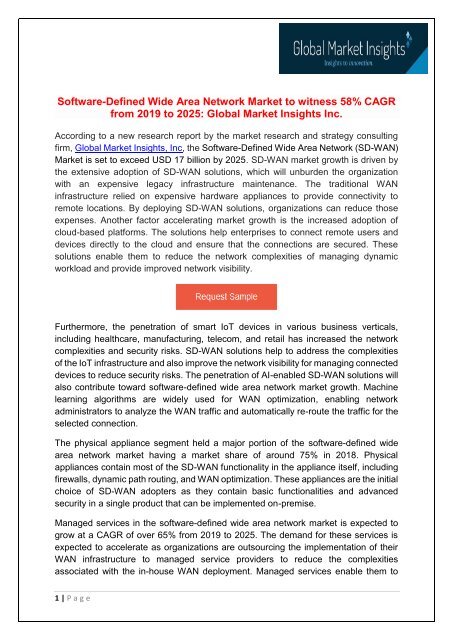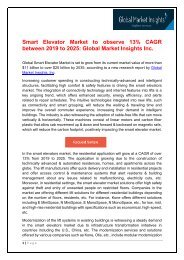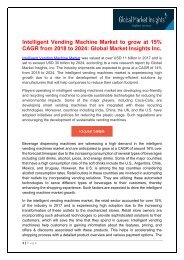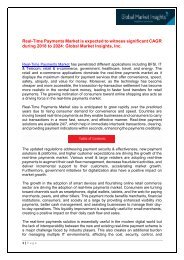PDF-SD-WAN Market
Create successful ePaper yourself
Turn your PDF publications into a flip-book with our unique Google optimized e-Paper software.
Software-Defined Wide Area Network <strong>Market</strong> to witness 58% CAGR<br />
from 2019 to 2025: Global <strong>Market</strong> Insights Inc.<br />
According to a new research report by the market research and strategy consulting<br />
firm, Global <strong>Market</strong> Insights, Inc, the Software-Defined Wide Area Network (<strong>SD</strong>-<strong>WAN</strong>)<br />
<strong>Market</strong> is set to exceed U<strong>SD</strong> 17 billion by 2025. <strong>SD</strong>-<strong>WAN</strong> market growth is driven by<br />
the extensive adoption of <strong>SD</strong>-<strong>WAN</strong> solutions, which will unburden the organization<br />
with an expensive legacy infrastructure maintenance. The traditional <strong>WAN</strong><br />
infrastructure relied on expensive hardware appliances to provide connectivity to<br />
remote locations. By deploying <strong>SD</strong>-<strong>WAN</strong> solutions, organizations can reduce those<br />
expenses. Another factor accelerating market growth is the increased adoption of<br />
cloud-based platforms. The solutions help enterprises to connect remote users and<br />
devices directly to the cloud and ensure that the connections are secured. These<br />
solutions enable them to reduce the network complexities of managing dynamic<br />
workload and provide improved network visibility.<br />
Furthermore, the penetration of smart IoT devices in various business verticals,<br />
including healthcare, manufacturing, telecom, and retail has increased the network<br />
complexities and security risks. <strong>SD</strong>-<strong>WAN</strong> solutions help to address the complexities<br />
of the IoT infrastructure and also improve the network visibility for managing connected<br />
devices to reduce security risks. The penetration of AI-enabled <strong>SD</strong>-<strong>WAN</strong> solutions will<br />
also contribute toward software-defined wide area network market growth. Machine<br />
learning algorithms are widely used for <strong>WAN</strong> optimization, enabling network<br />
administrators to analyze the <strong>WAN</strong> traffic and automatically re-route the traffic for the<br />
selected connection.<br />
The physical appliance segment held a major portion of the software-defined wide<br />
area network market having a market share of around 75% in 2018. Physical<br />
appliances contain most of the <strong>SD</strong>-<strong>WAN</strong> functionality in the appliance itself, including<br />
firewalls, dynamic path routing, and <strong>WAN</strong> optimization. These appliances are the initial<br />
choice of <strong>SD</strong>-<strong>WAN</strong> adopters as they contain basic functionalities and advanced<br />
security in a single product that can be implemented on-premise.<br />
Managed services in the software-defined wide area network market is expected to<br />
grow at a CAGR of over 65% from 2019 to 2025. The demand for these services is<br />
expected to accelerate as organizations are outsourcing the implementation of their<br />
<strong>WAN</strong> infrastructure to managed service providers to reduce the complexities<br />
associated with the in-house <strong>WAN</strong> deployment. Managed services enable them to<br />
1 | P a g e
educe their operational costs as the majority of the network functions are outsourced<br />
to third-parties. These factors are expected to drive the demand for managed services<br />
in the market.<br />
The on-premise deployment model is expected to hold the majority of the market share<br />
as this model enables IT architects of organizations to construct their own <strong>WAN</strong><br />
infrastructure and develop network policies according to their needs. The premisebased<br />
models enable enterprises to ensure that their networks are running securely<br />
and give them a direct control to handle the security aspects of the infrastructure.<br />
The manufacturing market is expected to exhibit the highest growth rate of over 60%<br />
from 2019 to 2025. The software-defined wide area network market growth is<br />
attributed to the growing popularity of IoT platforms. As sensors and smart devices are<br />
widely used in manufacturing facilities, the manufacturing companies require<br />
solutions, which can provide exceptional network visibility for managing those<br />
endpoints. <strong>SD</strong>-<strong>WAN</strong> solutions enable manufacturers to simplify the network<br />
management and prioritize network traffic to ensure that business-critical applications<br />
get the required connection. As the use of IoT devices and communication<br />
technologies in the manufacturing industry continues to rise, the demand for these<br />
solutions to support the connectivity across manufacturing facilities will increase.<br />
North America <strong>SD</strong>-<strong>WAN</strong> <strong>Market</strong> Revenue, By Application, 2018 & 2025 (U<strong>SD</strong><br />
Million)<br />
2 | P a g e
The software-defined wide area network market in Asia Pacific will show the fastest<br />
growth rate of over 61% over the forecast timeline. The market growth is driven by the<br />
growing adoption of cloud-based infrastructure by enterprises to achieve agility and<br />
improve application performance. The enterprises are adopting solutions to improve<br />
their network performance and reduce the complexity associated with the existing<br />
<strong>WAN</strong> infrastructure. Another factor accelerating market growth in the region is the<br />
adoption of network virtualization technologies to reduce the operational costs and<br />
enhance the automation of networks. For example, in December 2017, China Telecom<br />
selected ZTE for the provisional cloud resource pool pre-commercial trial <strong>SD</strong>N project.<br />
Under the collaboration, ZTE provided China Telecom with full series of <strong>SD</strong>N solutions<br />
to support the need for automatic resource pool deployment and resource pool<br />
interconnection while managing construction costs.<br />
The players operating in the market are focusing on product innovations to develop<br />
new offerings to cater to the evolving needs of enterprise networks. The companies<br />
are offering new and cost-effective solutions to help enterprises address the growing<br />
infrastructure demands. In September 2017, Huawei launched its <strong>SD</strong>-<strong>WAN</strong> solution<br />
and a series of universal computing gateway systems to provide enterprises with an<br />
on-demand interconnection between multiple branches and cloud. In August 2018,<br />
Cisco and Sify Technologies launched managed and secure <strong>SD</strong>-<strong>WAN</strong> service, built<br />
on the Cisco <strong>SD</strong>-<strong>WAN</strong> platform for Indian enterprises. The new service providers<br />
provide flexibility to the customers to easily transition from their existing network to a<br />
fully secure <strong>SD</strong>-<strong>WAN</strong> platform. Some of the companies are focusing on strategic<br />
acquisitions to expand their existing capabilities to gain more market share. For<br />
instance, in August 2017, Cisco acquired Viptela, Inc. to develop a next-generation of<br />
intent-based networking solutions. Through this acquisition, the company blended<br />
Viptela’s technology with its <strong>SD</strong>-<strong>WAN</strong> products to bring next-generation solutions to<br />
the market.<br />
Some of the key players in the software-defined wide area network (<strong>SD</strong>-<strong>WAN</strong>) market<br />
are, Aryaka, Barracuda Networks, Berkshire Partners LLC (Masergy<br />
Communications), Cato Networks, Cisco, Citrix, CloudGenix, Ecessa Corporation,<br />
Elfiq Networks, FatPipe Networks, Huawei, Infovista, Nuage Networks, Oracle,<br />
Peplink, Riverbed, Silver Peak, Versa Networks, Vmware, and ZTE.<br />
Browse key industry insights spread across 300 pages with 362 market data tables &<br />
31 figures & charts from the report, “<strong>SD</strong>-<strong>WAN</strong> <strong>Market</strong> Size By Component (Solution<br />
[Physical Appliance, Virtual Appliance], Service [Training & Consulting,<br />
Integration & Maintenance, Managed Service]), By Deployment Model (Onpremise,<br />
Cloud, Hybrid), By Application (IT & Telecom, BFSI, Healthcare, Retail<br />
& Consumer Goods, Government, Manufacturing), Industry Analysis Report,<br />
3 | P a g e
Regional Outlook (U.S., Canada, UK, Germany, France, Italy, Spain, Netherlands,<br />
China, Japan, India, Australia and New Zealand (ANZ), South Korea, Southeast<br />
Asia, Brazil, Mexico, Argentina, Colombia, South Africa, UAE, Saudi Arabia,<br />
Israel), Growth Potential, Competitive <strong>Market</strong> Share & Forecast, 2019 - 2025” in<br />
detail along with the table of contents:<br />
https://bit.ly/2jtOJYF<br />
Table of Content (TOC-)<br />
Chapter 1. Methodology & Scope<br />
1.1. Methodology<br />
1.2. Scope<br />
1.3. Definition<br />
1.4. Methodology and forecast parameters<br />
1.5. Data Sources<br />
1.5.1. Primary<br />
4 | P a g e
1.5.2. Secondary<br />
1.5.2.1. Paid sources<br />
1.5.2.2. Public sources<br />
Chapter 2. Executive Summary<br />
2.1. <strong>SD</strong>-<strong>WAN</strong> industry 360º synopsis, 2014 - 2025<br />
2.2. Business trends<br />
2.3. Regional trends<br />
2.3.1. Component trends<br />
2.3.1.1. Solution trends<br />
2.3.1.2. Service trends<br />
2.3.2. Deployment model trends<br />
2.3.3. Application trends<br />
Chapter 3. <strong>SD</strong>-<strong>WAN</strong> Industry Insights<br />
3.1. Introduction<br />
3.2. Industry segmentation<br />
3.3. Industry landscape, 2014-2025<br />
3.4. <strong>SD</strong>-<strong>WAN</strong> ecosystem analysis<br />
3.4.1. Hardware component providers<br />
3.4.2. Network service providers<br />
3.4.3. Communication service providers<br />
3.4.4. Managed service providers<br />
3.4.5. System integrators<br />
3.4.6. Distributors<br />
5 | P a g e
6 | P a g e<br />
3.4.7. End users<br />
3.5. <strong>SD</strong>-<strong>WAN</strong> architecture<br />
3.6. Architecture approaches for <strong>SD</strong>-<strong>WAN</strong><br />
3.7. <strong>SD</strong>-<strong>WAN</strong> technology evolution<br />
3.8. <strong>SD</strong>-<strong>WAN</strong> VS Traditional <strong>WAN</strong><br />
3.9. Technology & innovation landscape<br />
3.9.1. Network virtualization<br />
3.9.2. AI and machine learning<br />
3.9.3. 5G<br />
3.10. Regulatory landscape<br />
3.10.1. MEF 3.0 <strong>SD</strong>-<strong>WAN</strong> Service Attributes and Service Definition<br />
Standard<br />
3.10.2. The National Institute of Standards and Technology (NIST), U.S.<br />
3.10.3. European Telecommunications Standards Institute (ETSI) GS<br />
NFV -IFA 008<br />
3.10.4. The Open Compute Project and OPNFV<br />
3.10.5. ISO/IEC 270001<br />
3.10.6. IEEE <strong>SD</strong>N/NFV Standardization<br />
3.11. Industry impact forces<br />
3.11.1. Growth drivers<br />
3.11.1.1. Increased adoption of <strong>SD</strong>-<strong>WAN</strong> in manufacturing due to<br />
rising IoT trend<br />
3.11.1.2. Growing need among organizations to simplify network<br />
management<br />
3.11.1.3. Implementation of <strong>SD</strong>-<strong>WAN</strong> for CAPEX and OPEX<br />
savings
3.11.1.4. Increased business agility and responsiveness<br />
3.11.1.5. Rapid migration towards cloud-based applications<br />
3.11.2. Industry Pitfalls and Challenges<br />
3.11.2.1. Lack of in-house expertise<br />
3.11.2.2. Concerns related to data security<br />
3.11.2.3. Issues related to operationalization of hybrid networks<br />
3.12. Porter’s Analysis<br />
3.12.1. Threat of new entrants<br />
3.12.2. Threat of substitutes<br />
3.12.3. Bargaining power of buyer<br />
3.12.4. Bargaining power of supplier<br />
3.12.5. Industry rivalry<br />
3.13. PESTEL analysis<br />
3.14. Growth potential analysis<br />
Chapter 4. Competitive Landscape, 2018<br />
4.1. Introduction<br />
4.2. Competitive analysis of key market players<br />
4.2.1. Aryaka<br />
4.2.2. Cisco<br />
4.2.3. Silver Peak<br />
4.2.4. VMware<br />
4.3. Competitive analysis of prominent vendors<br />
4.3.1. Citrix<br />
7 | P a g e
4.3.2. Huawei<br />
4.3.3. Infovista<br />
4.3.4. Riverbed<br />
Industry Coverage<br />
8 | P a g e
About Global <strong>Market</strong> Insights<br />
Global <strong>Market</strong> Insights, Inc., headquartered in Delaware, U.S., is a global market<br />
research and consulting service provider; offering syndicated and custom research<br />
reports along with growth consulting services. Our business intelligence and industry<br />
research reports offer clients with penetrative insights and actionable market data<br />
specially designed and presented to aid strategic decision making. These exhaustive<br />
reports are designed via a proprietary research methodology and are available for key<br />
industries such as chemicals, advanced materials, technology, renewable energy and<br />
biotechnology.<br />
Contact Us:<br />
Arun Hegde<br />
Corporate Sales, USA<br />
Global <strong>Market</strong> Insights, Inc.<br />
Phone: 1-302-846-7766<br />
Toll Free: 1-888-689-0688<br />
Email: sales@gminsights.com<br />
Web: https://www.gminsights.com<br />
Blog: www.industry-source.org<br />
9 | P a g e

















